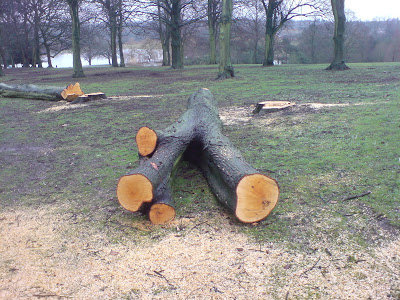Someone once said to me that the trouble with experts is they give us expert advice whether we need it or whether we can afford it.
I suppose that this is why, in our general ignorance of expert matters, we ordinary folk see a good deal of expert thinking manifested in ways which are quite beyond our inexpert comprehension.
And this causes us to question expertly done things, which we really shouldn't do.
I mean, if a local authority appoints someone to an expert position, it goes without saying that expert advice will be given; and quite likely, expert actions will follow, and we will all be immeasurably better off, even if we don't immediately realise it.
Take, for example, the appointment of an expert, not too far from Sandwell, who caused some 60 oak trees to be felled, 2 or 3 years ago, in the middle of a bit of countryside - also not too far from Sandwell. Now, to the inexpert eye, there didn't seem to be any particularly good reason for this - I mean, english oaks being chopped down in the english countryside seems a bit odd.
But upon enquiry, the expert concerned, (who's no ordinary expert - this expert's a PhD!!), explained that these trees 'were in the migration line of the wheatear' (a bird) and as he wished to encourage the wheatear to fly around that particular area, it was necessary to cut down the offending oaks. He added, comfortingly, that there were too many oaks there anyway!
Of course!! Why didn't I think of that? Foolish me, to doubt that there would be even one good reason for cutting down 60 oak trees, let alone 2 very good reasons.
This is the trouble with us non-experts. We don't have the necessary experience or intellectual capacity to understand so many things. And that is why we really shouldn't question things we don't understand, particularly if they are instigated by a local authority, like Sandwell, whose intellectual prowess must have few equals.
(Oh yes. I've come back to dear old Sandwell.)
I have to admit that I have, on occasion, questioned Sandwell's actions, and, I am ashamed to say, I have even implied that some of its actions may have been irrational; shameful; non-ecological, and generally appalling. But that was before I realised that Sandwell not only does what is best for us all, it probably does so on the basis of expert advice. Now that I think about it, I am amazed that Sandwell was judged to be one of the worst 4 councils in the country last year, or that the Sunday Times had the temerity to report that this was so.
Accordingly, I would like to clarify my new thinking on a matter about which I have previously commented.
It is that of the 50 or so poplar trees which are, or were, in two parallel lines either side of the boat house at Sandwell Valley's Swan Pool. A notice, put up by Sandwell, said 'These poplars had become dangerous and though regrettable it was essential that they be removed for public safety reasons.'
With the benefit of hindsight, the axing of the 100 year old poplars was clearly quite correctly done, and almost certainly on expert advice. Those of us who saw little sign of decay in the trunks of the felled trees obviously lacked the necessary perception or experience to recognise dangerous trees when we saw them. Those of us who thought that maybe one or two, or just possibly 5 or 6, or perhaps, at a long shot, half of the trees, were dangerous, were just plain wrong. Of course, it's obvious now, given the guidance of the Sandwell experts, that in 2008 (not 2007) ALL of the poplars - every single one of them - had become dangerous - all at the same time!
There were those who thought that the axing of the poplars had something to do with a CCTV camera which was erected on top of the boathouse, coincidentally, also in 2008. They conjectured that as one of the two lines of poplars would have blocked the camera's view of the adjacent car park, (which itself, also coincidentally, had been upgraded in 2008)then Sandwell had to find some reason, however tenuous, to chop them down.
Well I hope that those people have now realised the error of their surmises.
I hope that they can now see, nearly 2 years on from those first faltering Sandwell fellings, that the expert Sandwell intellectual elite, even then, had a vision far beyond that of the common man. Even then, the plans must have been firmly laid to axe the, by now, many hundreds of trees of which Sandwell have since disposed. Better still, the meagre 100 years which many of the poplars claimed, are well and truely outstripped by the ages of some of the 2010 casualties.
Thank goodness for experts, and thank goodness that Sandwell, eventhough it has spent so much of its money on The Public (art gallery), still has enough to employ experts with such vision, and subcontract arborealists with such capacity.













